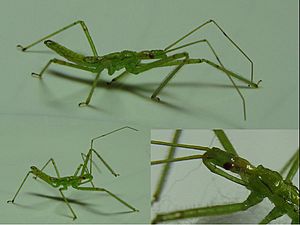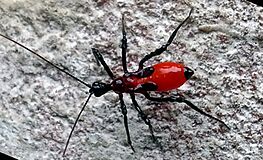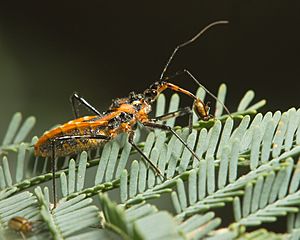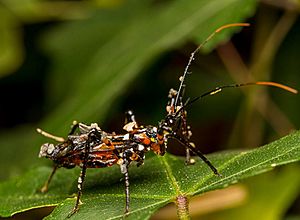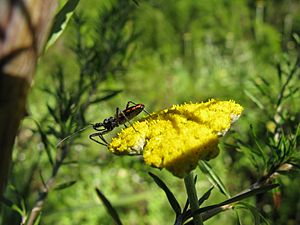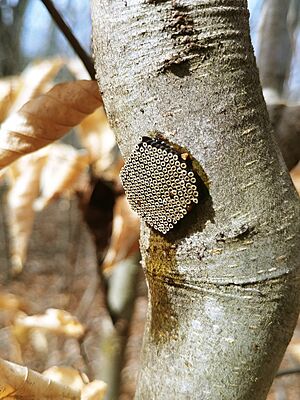Assassin bug facts for kids
Quick facts for kids Assassin bug |
|
|---|---|
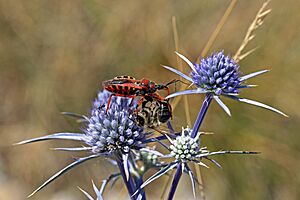 |
|
| Assassin bug (Rhynocoris iracundus) with bee prey | |
| Scientific classification |
|
| Kingdom: | Animalia |
| Phylum: | Arthropoda |
| Class: | Insecta |
| Order: | Hemiptera |
| Infraorder: | Cimicomorpha |
| Family: | Reduviidae Latreille, 1807 |
| Subfamilies | |
|
Bactrodinae |
|
The Reduviidae, commonly known as assassin bugs, are a huge family of true bugs found all over the world. Most assassin bugs are predators, meaning they hunt and eat other insects. They are one of the few groups of predatory bugs that live on land, unlike many others that live in water.
While most assassin bugs are hunters, a few types, like the "kissing bugs" in the Triatominae subfamily, feed on blood. Some of these blood-feeding species, especially in South America, can spread a serious illness called Chagas disease.
Most assassin bugs are easy to spot. They usually have a thin neck, a strong body, and a powerful, curved mouthpart called a proboscis. It's best to be careful if you see a large one, as they can give a very painful bite with their proboscis if they feel threatened.
Contents
What are Assassin Bugs?
The assassin bug family is very large, with about 7,000 different species discovered so far. They belong to a bigger group of insects called Hemiptera, which includes all "true bugs." Most of these bugs are predators, but a small number, like the kissing bugs, feed on blood. Some of these blood-feeding bugs are known to carry diseases.
Their Amazing Body
Assassin bugs come in many sizes, usually from about 12 to 36 millimeters long. They often have a long head with a clear, narrow neck. Their legs are usually long, and their most noticeable feature is their strong, segmented proboscis. Many species are brightly colored, often in shades of brown, black, red, or orange.
How They Look
A special part of the assassin bug's body is how its proboscis fits into a grooved area on its chest. This groove has ridges, and the bug can rub its proboscis against these ridges to make sounds.
Making Sounds
These sounds are often used to scare away animals that might try to eat them. If an assassin bug feels bothered, it can use its proboscis to deliver a painful bite. This bite can inject special fluids that can be quite uncomfortable.
How Assassin Bugs Hunt and Eat
Predatory assassin bugs use their long proboscis to inject a special saliva into their prey. This saliva turns the insides of the prey into liquid, which the bug then sucks out. This process is called "extraoral digestion" because the digestion starts outside the bug's body. Their saliva is strong enough to kill prey much larger than the bug itself!
Clever Hunting Tricks
Some assassin bugs have legs covered in tiny hairs that help them hold onto their prey tightly. Others, especially those in the Phymatinae subfamily, have front legs that look like those of a praying mantis. They use these strong legs to grab and hold their prey in a similar way.
Young assassin bugs, called nymphs, are very good at camouflage. They often cover themselves with dirt or the remains of insects they've eaten. For example, the "masked hunter" bug (Reduvius personatus) covers itself with dust to hide.
Special Diets
Some assassin bugs are helpful to humans because they eat pests like cockroaches or bedbugs. People sometimes even keep them as pets or for natural pest control. Different types of assassin bugs specialize in hunting certain prey. For instance, some eat millipedes, while others, like the "feather-legged bugs," hunt ants. A fascinating example is the Australian Ptilocnemus lemur, where the adult eats ants, but the nymph waits for an ant to bite the feathery tufts on its hind legs. When it does, the nymph quickly turns and stabs the ant's head with its proboscis to feed.
The "Kissing Bugs"
Not all assassin bugs are predators. Some species are bloodsuckers, which means they feed on the blood of animals, including humans. These bugs are thought to have started living in the nests of mammals.
Species like those in the Triatoma genus and other members of the Triatominae subfamily are often called "kissing bugs." This is because they tend to bite sleeping people in soft areas like around the lips and eyes.
A more serious concern than their bite is that several of these blood-feeding species, found mainly in Central and South America, can carry tiny parasites. These parasites can cause a serious illness called Chagas disease, also known as American trypanosomiasis, which can cause serious health problems for many people each year.
Assassin Bug Family Tree
Scientists study the features of assassin bugs, including their bodies and their DNA, to understand how they are related to each other. They believe that all assassin bugs came from a common ancestor, making them a "monophyletic" group.
Naming the Bugs
The name Reduviidae comes from the main type of bug in this family, called Reduvius. This name comes from a Latin word, reduvia, which means "hangnail" or "remnant." This might refer to the flat parts on the sides of many assassin bugs' bodies.
Here are some common groups of assassin bugs:
- Lopodytes
- Melanolestes
- Platymeris
- Pselliopus
- Psyttala
- Rasahus
- Reduvius
- Rhiginia
- Sinea
- Zelus
While many assassin bugs are just called "assassin bugs," some subfamilies have their own special names:
- Ambush bugs – like those in the Phymatinae subfamily
- Thread-legged bugs – found in the Emesinae subfamily, including the Emesaya genus
- Kissing bugs (or cone-headed bugs) – these are the blood-sucking ones in the Triatominae subfamily
- Wheel bugs – from the Arilus genus, like the Arilus cristatus found in North America
- Grass assassin bugs – from the Lopodytes genus
A Look Back in Time
Scientists use clues like fossils to learn about the history of assassin bugs. They believe these bugs first appeared a very long time ago, during the Jurassic period. The oldest known fossils of assassin bugs are from about 100 million years ago. These ancient fossils, including young bugs (nymphs) and a genus called Paleotriatoma, were found preserved in amber from what is now Myanmar.
Famous Assassin Bugs
- Arilus cristatus (the Wheel Bug) is a well-known example.
See also
 In Spanish: Chinches asesinas para niños
In Spanish: Chinches asesinas para niños


